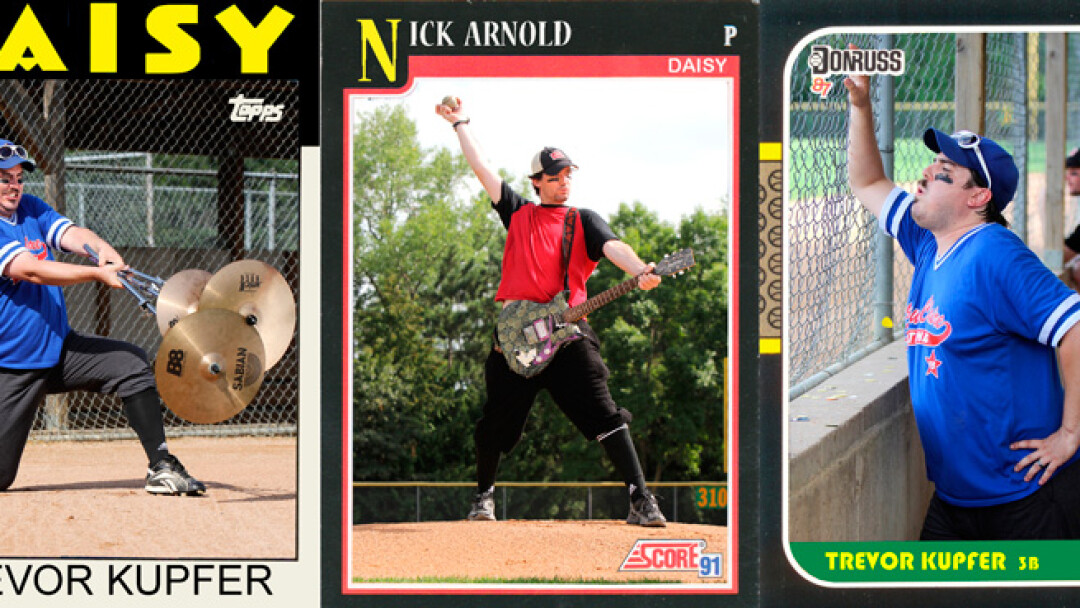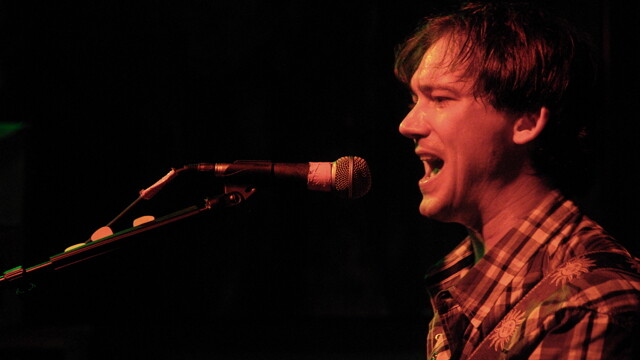For the Love of the Game
DIY Daisy supersizes its raw rock on new record
Andrew Patrie, photos by Andrea Paulseth |

The creepy kids from down the block may have grown up a bit, got themselves jobs, but don’t let those clip-on ties fool you; they’re (still) plenty capable of making mayhem and mischief. Do It Yourself Daisy are back with a new full-length, The Local Machine (three years on from their eponymous debut), and they’re ready to fissure the floor ’neath your feet and find that G-chord spot all over again.
The signature sound of Trevor Kupfer’s tom-heavy stomp and Nick Arnold’s bluesy, dragged-over-oil-stained -concrete guitar tone remain intact, as does the “we just set up in the garage and hit record on our boom box” ambience. But the production also sounds/feels punchier this time round. Kupfer compromises, “A lot of people didn’t get what we were going for the first time. They heard a false start or extra buzzing (and) they associated it with amateurism. They thought those were things we forgot to remove, when really we put them in on purpose. This time around we recorded at a top-of-the-line studio” – April Base – “but we still left in some raw guitar sound and talking/miscues. Maybe people will get what we’re going for now. That you’re a part of something intimate, off-the-cuff, and raw.”
“A lot of people didn’t get what we were going for the first time. They heard a false start or extra buzzing (and) they associated it with amateurism.” – Trevor Kupfer of Do It Yourself Daisy, about the band’s debut record
Certainly, listeners should find it difficult to remain unmoved as the album pulses with slinky, sinistral groove on the Pixies-ish “Crashed Again,” the rockin’ and rollin’, like heads into a guillotine basket, of the Sabbath-ian “You Don’t Belong,” the proto-punk styling of “Lazer Eyes,” future fan favorite “Danger Surrounded Carlos” and the decidedly dark ’n’ disconsolate “Self-Assembling Mechanism” replete with Arnold’s “how could you leave me” haunt of a howl. However, there’s much humor to be had as well in the Dead Milkmen-like “Sea Monsters Attack, But Humanity Prevails” and the Spinal Tap-esque chant of “Paul Bunyan.” There are even a couple of “epic” numbers (i.e., the five-minute plus “Merry-Go-Round” which will get you spinning like a politician with its poppy core and Neil Young-style bridge).
Nineteen songs in total (almost double the number on their debut) and a running time twice as long as last, have DIYD abandoned their aesthetic of the perfect song nestling somewhere between two and three minutes? Arnold ripostes, “Are you saying that it’s too long? I still believe in the 2½-minute song length. All of the long songs are the result of a particular recording session we did with Jaime Hansen that involved Bushmills. The idea was to just let things happen. We still have a lot of raw, rockin’ tunes, but there’s some slower stuff, and some melody-driven tunes, as well. I hope people don’t get bored listening. I, for one, have been aware of the possibility of the sophomore album curse of trying to do too much. But, in the end, some of my favorite albums are like a schizophrenic’s notebook. My hopes are that people take a journey with us. However, if people only like a couple tunes, that’s fine too. I’m just glad they’re listening.”

Speaking of boredom, one of the disc’s most welcome surprises is penultimate track “I Just Get Bored,” an acoustic number featuring the line of the album, unmatched elsewhere in its deranged poignancy, “cut off his hands now he’ll never hold no one again,” and delivered by someone other than Arnold. He explains, “The singer is Emily Hartman (who is also a great visual artist). ‘I Just Get Bored’ was always intended as a duet. It’s about the dark fantasies that come to one’s mind when they’re finished with a relationship. I like it at the end of the album. It’s like a cigarette after sex.”
One significant change since 2011 is the new distance, geographically speaking, between the duo. Kupfer has relocated to the Twin Cities and tush-tushes, “A lot of people ask us (about) that. I suspect it’s because the default thinking when this sort of thing happens is that we’re done for, broken up. But we rarely wrote new material together. We certainly don’t practice as much as we did before, and it’s making it so we have to be more individually motivated, but we keep booking shows and putting in the time to keep doing what we do because we enjoy it.”
Sure sounds like the DIYD this scene has grown to love, if only a tad more (re)fine-tuned: still hooky and eclectic and, in spite of my myriad references above, as difficult to label as the ingredients in a gas station hoagie. Kupfer concludes, “We kind of started with a wide funnel and have slowly focused that down to make DIYD. You can still hear a wide variety of stuff on the record, but I hope people still have difficulty labeling us; that means we’ve done something right.”
Do It Yourself Daisy will play The House Of Rock, 422 Water St., Feb. 15 with Kids With Boats, Puncher, and Ghost Foot. You can find more music at DIYDaisy.bandcamp.com.




















